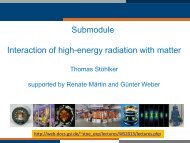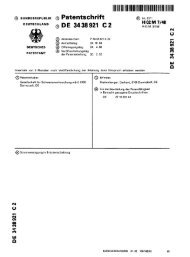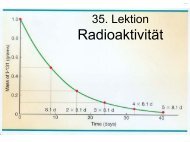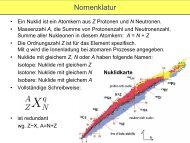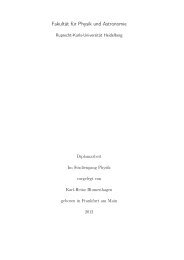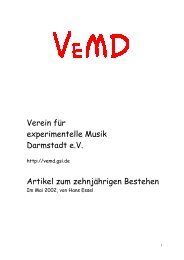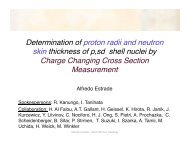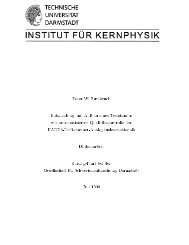doctoral thesis
doctoral thesis
doctoral thesis
Create successful ePaper yourself
Turn your PDF publications into a flip-book with our unique Google optimized e-Paper software.
16 CHAPTER 1. INTRODUCTION<br />
The energy loss connected with this process is negligible but it is used in the detection<br />
and identification of particles (electron/pion separation, pion/proton separation<br />
and other). ˘Cerenkov counters utilize one or more of the properties of ˘Cerenkov radiation:<br />
the existence of a threshold for ˘Cerenkov radiation, the dependence of Θc on<br />
the velocity v = βc of the particle and/or the dependence of the number of emitted<br />
photons on the velocity of the particle.<br />
Transition Radiation<br />
Characteristic transition radiation is used for identifying fast electrons in Transition<br />
Radiation Detectors (TRDs; for example, see [24]). Consider a particle of charge ze<br />
crossing a boundary between vacuum and a material with a plasma frequency ωp<br />
given by Eq. 1.13. For typical radiator materials (Styrene) it is about 20 eV. The<br />
radiated energy is<br />
Etr = α z 2 γ ωp<br />
3<br />
. (1.19)<br />
The typical emission angle is 1/γ. Several layers of material lead to several boundaries<br />
which increases the radiated energy. The radiated energy increases with γ. Since<br />
electrons are in general the fastest particles observed in an experiment (due to their low<br />
mass), TRDs can provide electron/pion separation in the momentum range 0.5 GeV/c<br />
p 100 GeV/c [24].<br />
Photon Interactions with Matter<br />
We distinguish three processes in which photons interact with matter:<br />
Photo Electric Effect: The interaction of the photon with the atom as a whole leads<br />
to the Photo Electric Effect. The photon is absorbed and an electron is emitted<br />
from the atom, e.g.<br />
γ + atom → atom + + e − .<br />
The cross section falls at high energies roughly as Z 5 /ω [19], where Z is the<br />
atomic charge number of the absorber material and ω is the energy of the photon.<br />
The Photo Electric Effect is important up to energies of around 100 keV<br />
(10 MeV) for materials like carbon with Z = 6 (lead with Z = 82).<br />
Compton Scattering: The interaction of the photon with a free electron leads to the<br />
Compton Effect. The photon transfers a part of its energy and momentum to the<br />
electron initially at rest, e.g.



